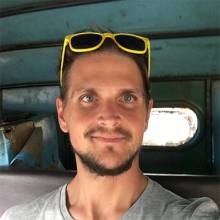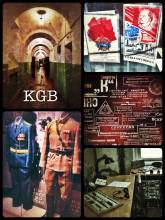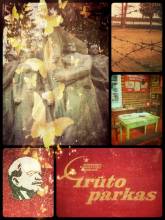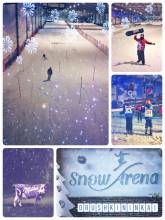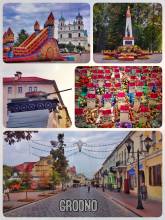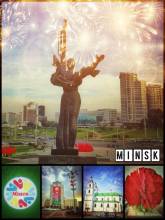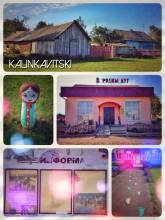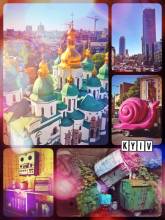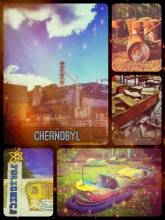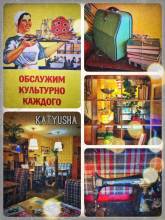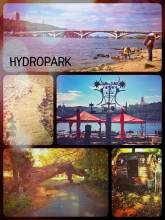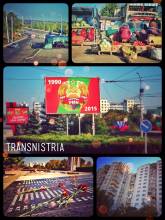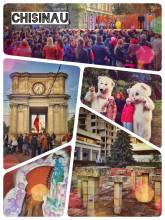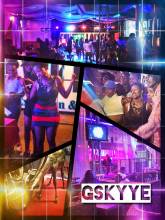The Soviet heritage
Introduction: going further and further
Exploring the Baltic States prepared me for the visit of other former Soviet countries. The current Ukraine crisis made me reconsider, while chatting online with locals strengthened my determination. Residents as well as travelers ensured me that life is in full blossom. I wanted to see for myself, how people are living and what happened since the fall of the Soviet Union. So I decided to cross Belarus
crisis made me reconsider, while chatting online with locals strengthened my determination. Residents as well as travelers ensured me that life is in full blossom. I wanted to see for myself, how people are living and what happened since the fall of the Soviet Union. So I decided to cross Belarus , Ukraine and Moldova
, Ukraine and Moldova .
.
Baltic States: the real center of Europe
After dropping my friend at the airport of Vilnius, I was by myself again. To get adjusted, I stayed a few more days in Lithuania . Vilnius and its surroundings has culturally a lot to offer. In museums and historic sites, I learned much about Eastern European history - long before and during the Soviet times. In fact, the Soviet leftovers are slowly disappearing, as the Baltic States are strongly orienting towards the West. At the Europos Parko I even discovered, that Vilnius is the center of the European continent. My final stop brought me to the wellness resort Druskininkai. There I relaxed in a spa after riding the snowboard in an indoor arena.
. Vilnius and its surroundings has culturally a lot to offer. In museums and historic sites, I learned much about Eastern European history - long before and during the Soviet times. In fact, the Soviet leftovers are slowly disappearing, as the Baltic States are strongly orienting towards the West. At the Europos Parko I even discovered, that Vilnius is the center of the European continent. My final stop brought me to the wellness resort Druskininkai. There I relaxed in a spa after riding the snowboard in an indoor arena.
Belarus: culture and happiness in isolation
Coming from Western Europe , I know nothing about life in Belarus. When entering and moving within the country, the Soviet influence is still very present. It starts with the unbearable bureaucracy of visa and insurances. It also shows in its architecture with huge apartment blocks and monuments. Surprisingly, the infrastructure is very modern and cultural life is blossoming. Festivals, theatre, circus, night clubbing ... you name it. Observing the presidency election was another highlight: while the event was wildly promoted, candidates were practically invisible. Nevertheless, people seem very happy and welcomed me openheartedly. Even at the border officers were delighted about a visitor from Switzerland
, I know nothing about life in Belarus. When entering and moving within the country, the Soviet influence is still very present. It starts with the unbearable bureaucracy of visa and insurances. It also shows in its architecture with huge apartment blocks and monuments. Surprisingly, the infrastructure is very modern and cultural life is blossoming. Festivals, theatre, circus, night clubbing ... you name it. Observing the presidency election was another highlight: while the event was wildly promoted, candidates were practically invisible. Nevertheless, people seem very happy and welcomed me openheartedly. Even at the border officers were delighted about a visitor from Switzerland . The young generation speaks English, is well informed and interested in the world.
. The young generation speaks English, is well informed and interested in the world.
Ukraine: a land of crisis, corruption and change
War, corruption and terrible roads - many people warned be of the Ukraine. It is true, the first roads I encountered were barely passable. The holes were not only wide, but also deep and numerous. But the main roads around Kyiv and Odesa (Ukrainian spelling!) were fully intact. In comparison to other European places, the general mood on the streets was a bit damped. Due to the inflation and oil shortage, people save energy and travel less abroad. The effect is best visible at night, when Kyiv is turning unnaturally dark. Nevertheless, people are optimistic about the future and living their life as usual. Me and my car survived without a single scratch or bribery.
Moldova: and yet another independent country inside
Coming from Odesa, I entered Moldova via Transnistria . This tiny region is the most backward place, I have seen on my journey. After the Soviet fall, it declared its independency and proclaimed its own (mostly unrecognised) state. The administrative hurdles on entering by car are especially high. I had to exchange to their own currency and pay for insurance as well as road taxes. On the countryside and the capital city, I encountered clean streets, yet deteriorating buildings. The rest of Moldova looks slightly better, but is still pretty run-down. Current anti-corruption protests where just drowned in official festivities. Years of mismanagement and corruption left its traces.
. This tiny region is the most backward place, I have seen on my journey. After the Soviet fall, it declared its independency and proclaimed its own (mostly unrecognised) state. The administrative hurdles on entering by car are especially high. I had to exchange to their own currency and pay for insurance as well as road taxes. On the countryside and the capital city, I encountered clean streets, yet deteriorating buildings. The rest of Moldova looks slightly better, but is still pretty run-down. Current anti-corruption protests where just drowned in official festivities. Years of mismanagement and corruption left its traces.
Summary: people get what they fight for
The differences between those former Soviet countries could not be bigger. Starting in the northern Baltic States, I found an outpost of Europe. The Ukraine is currently shifting its orientation, but is still struggling with its heritage. Despite its isolation, Belarus did pretty well and is slowly opening up. At the same time, Moldavia and especially Transnistria seem to be stuck in the past. Driving through some of the easternmost countries of continental Europe was truly inspiring and revealing.



